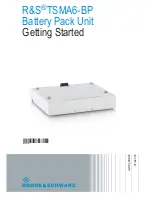
3.7.6
Tilt sensors
The tilt sensor system disables the power from the incoming low voltage source
when a tilt sensor detects a tilt of a cabinet of the EVSE in any direction. The
tilt sensor is generally closed and opens when the tilt decreases 10° in any
direction, for example if a vehicle impacts against the EVSE. In these situations,
the undervoltage release in the branch circuit breaker that supplies power to the
EVSE is de-energized and the branch circuit breaker opens.
The undervoltage release in the branch circuit breaker needs voltage input, to allow
the closure of the branch circuit breaker. The manufacturer recommends to use and
an uninterruptible power supply for the 24 V DC, to prevent tripping of the branch
circuit breaker.
The illustration shows the tilt sensors interface with the power distribution system
of the site. Please note that the shown branch circuit breaker, 24 V DC supply
delivered from an UPS, and all other components are not within the scope of ABB
E-Mobility, therefore are not provided in the EVSE.
The owner is responsible for considering a voltage drop on the 24 V DC circuit. The
owner must make sure that the undervoltage release of the branch circuit breaker
receives the correct input voltage according to the required specifications. Refer to
I
H
G
F
E
A
C
D
B
A
Power distribution board
B
Branch circuit breaker
C
Power inlet
D
EVSE
E
Tilt sensor
1
F
Output
G
Input from the uninterruptible
power supply
H
Uninterruptible power supply
I
Undervoltage release
2
1
) The tilt sensor has a contact that is closed when the tilt sensor is de-enenergized
and there is no tilt detected. When the contact is closed, the output is 20-24 V DC.
When the contact is open, the output is 0 V DC.
2
) The breaker will trip in the event of loss of voltage to the undervoltage release (I)
It is possible to install tilt sensors afterwards. Ask ABB EV Infrastructure. Refer to
.
Description
9AKK108466A3703-EN | 001
31
















































